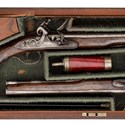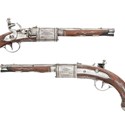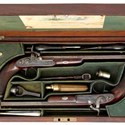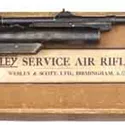The earliest collectors of firearms were probably monarchs intent on amassing armouries to demonstrate their wealth and power. They also became patrons, employing expert craftsmen to create better and more powerful weapons, as well as commissioning elaborately decorated guns that are rightly considered works of art in their own right.
Such weapons are among the most eagerly sought by collectors today, but this is a field where even the crudest military weapons will have their devotees and rare examples of special technical interest can command high prices.

In the USA, Colt developed its semi-automatic pistol based on the designs of John Browning. An example of the slab-sided .38 M1900 turned up at Gavin Gardiner’s (25% buyer’s premium) sale in London in December 2018 where it made £3000. Browning stripped this version of all extra catches and levers. The safety catch was a defining feature. In this case it was a simple adaptation of the rear sight which could be depressed to block the fall of the hammer. This proved cumbersome in practice and was soon abandoned.
What Do People Collect?
It is the almost limitless range of variations created during the four-century evolution of firearms, from matchlock to centrefire, which fuels the market in antique guns.
The earliest guns were fired by applying a burning fuse to a small touch hole in the barrel to ignite the gunpowder. The matchlock was simply a means of lowering the fuse when a trigger was pulled. The development of ever more efficient means of ignition is one of the major strands in the history of gun making and gun collecting.

Above: an 1836 Colt No 5 Texas Paterson revolver sold for a hammer price of $850,000 at Heritage auctions in Dallas in September 2011. This was a rare and very special pistol which heralds the beginning of the era of mass-production.
The 16th century saw the development of wheel-locks, where an ignition spark was produced by a flint held against a clockwork-powered steel wheel. The flintlock, the principal means of ignition for two centuries from the 17th century onwards, was fired when a flint clamped into a cock or hammer struck a hinged steel plate sending a shower of sparks into a pan of priming powder.
From the 1830s the discovery of compounds which would ignite when struck led to the almost universal adoption of the percussion lock and by the end of the 19th century this were overtaken by breech-loading guns with ready-loaded cartridges ignited by means of a firing pin.
Most collectors will tend to specialise in some way, perhaps tending towards weapons of a certain period or by a particular maker, or group of makers.
Different types of gun were created for sport, for military use or for self-defence, offering further possibilities for specialisation. The code of honour which meant that every gentleman was expected to own a pair of pistols for duelling has provided collectors with a rich source of fine boxed pistols from the 18th and 19th centuries (many of them hardly used) and these are keenly collected.
On the whole the gun collecting community is fairly self-contained, but there are weapons of great beauty that can credibly aspire to be works of art and which will attract interest from a wider audience. Some of the most expensive firearms on the market are those of exhibition quality that were always intended to be admired rather than used.
The Market
Though spectacular prices are paid for guns, particularly in the USA, the firearms market is generally considered to be less volatile than many other collecting areas. Gun collectors tend to be genuine enthusiasts with a scholarly approach who have a shared sense of values and a shrewd idea of price. For instance, the best pairs of 18th and 19th century English boxed pistols have long considered among the most desirable guns and have held their value well, more than keeping up with inflation. On the other hand, interesting examples of standard military or civilian pistols can still be purchased for hundreds rather than thousands of pounds.
Prices have risen more steeply in the United States where firearms have a special place in the culture and history of the country. Examples of the rarest and finest weapons by iconic names like Colt have commanded hundreds of thousands of dollars.

An early 19th century Turkish blunderbuss decorated with silver scroll work, made for the bodyguard of an Ottoman Sultan, which took £35,000 at Christie’s South Kensington in London in November 2010. Elaborately decorated arms from the East have leapt in price in recent years.
The sheer numbers produced by factories like Colt mean that standard examples of even quite early guns can be bought for hundreds rather thousands. Variations from the norm, often identified by small technical details or serial number, will be assigned higher values and these are generally well documented. The same applies to guns manufactured in smaller numbers, often by short-lived American factories attempting to compete with the big names.
In recent years there has also been an upsurge of interest in weapons from the Middle East and India. Exotically decorated guns were often brought back to Europe as curios but some are now making serious sums as interest grows in their countries of origin.
A collector of, say, 19th century English sporting guns can still build up an excellent collection by paying prices in the low thousands and there are other niche markets where enthusiasts can build a collection even more cheaply. For instance there is increasing interest in early to mid 20th century airguns. In this field prices are often under £100 and £1000 buys a real rarity.
The Law
In most countries antique guns can be freely bought and sold, either at auction or through dealers, but the definition of antique varies from country to country.
The United Kingdom has strict laws which govern the ownership of firearms, but a special exemption applies to antique guns kept for curiosity or ornament. The term antique is not defined in law but it is usually assumed that all muzzle-loading weapons are exempt, as are breech-loading weapons where the calibre of ammunition is now obsolete. Clearly the identification of model and calibre (whether obsolete or not) requires some expertise and advice should be sought where there is any doubt.
Pointers to Value
Condition is probably the most important factor to consider. Any antique weapon which appears to be in unfired condition with its original finish intact will be seen as exceptional and command a premium price.

A rare 1837 Poole Patent turret pistol made by James Wilkinson & Son which sold for £33,000 at Bonhams in London in July 2012. The high price reflected the combined attractions of a great technical rarity in excellent condition with its original box and accessories, backed with a history of ownership which included the renowned collector W. Keith Neil.
Conversely, excessive wear, pitting from corrosion, cracks and other defects will depress value. Some defects such as worn chequering on grips can be refreshed by a skilled restorer, but a refinished weapon will always be worth less than one in good original condition. Buyers should make a very careful examination of any gun where the finish looks too good to be true.
Rarity will also affect value. Collectors will tend to pay a premium for early examples of technical innovation or for novel items that were only made in small numbers. For instance, there are collectors who specialise in early examples of percussion ignition or attempts to create reliable multi-shot actions. They will sometimes overlook minor defects to obtain a rare example of technical interest.
Makers' names are important. The names Purdey, Manton, Holland & Holland or Boutet, for example, are synonymous with quality and guns by them generally command premium prices, though condition is still of paramount importance.
Completeness is a virtue. There is always greater interest in guns that are still in the original maker's case with all accessories. On the other hand, missing parts such as cocks or ramrods will have a negative effect on value.
Provenance and association should also be taken into account. Previous ownership by one of the great collectors such as William Keith Neal, whose collection was dispersed in a series of landmark sales from 1995 onwards, is often taken as a guarantee of quality. Weapons that can be traced back to one of the great royal armouries will also have special status, while guns that have been used by royalty or owned by one of the renowned sporting shots of the past will also be of special interest.
Further Reading
Encyclopedia of Firearms, Harold L. Peterson Ed., 1970
Flayderman's Guide to Antique American Firearms and Their Values, Norm Flayderman, 2007 ISBN 089689455X

























